
 |
|||||||
|
|
|
|
|
|
|
Few histories of the Easterner Exodus are objective. The involvement of major Easterners in the Last World War and the M'kkiae War, followed by the genocidal conquest of Victoria and the oppressive Hachiman invasions left a bitter taste throughout the Third Millennium, and the continued hostility of Libertine King John Anderson stoked anti-Easterner feelings throughout his nearly three thousand year rule. On the other hand, Novan revisionism in the late Fourth and Early Fifth Millennium portrayed the Easterners as bold pioneers and harried refugees who built an interstellar Empire from scratch and who survived its demise to create a mysterious distant Human state near Deneb, far beyond the Dragon Sphere. The truth, as usual, is somewhere between these extremes and often hard to discern after so many centuries. It is undisputable that the nearly one thousand original Easterners were the first Humans to leave the Solar system on their own and that they eventually founded eight interstellar colonies in the 23rd Century. And if Dragon claims are to be believed, the distant descendants of those refugees rule the largest, most advanced and most distant contemporary Human State.
In 2052AD, during the final months of the Last World War, Eastern Alliance Task Force 17, commanded
by Rear Admiral Yasuhiro Narita, retreated from the fallen Mars Battle Control Station into
the main asteroid belt. The remanent forces
seized control of the civilian JAXA Deep Space Research Station 4, home to a premiere engineering lab
focusing on
prototype ramscoop, fusion and magnetic drive development. Rallying the
surviving Japanese spacecraft in that sector of the belt, Narita supervised the
conversion of the prototype ramscoop planetoid into an interstellar hibernation sleeper
ship. Even as cease-fire talks began at Copernicus, nine hundred fifty mostly Japanese
soldiers and scientists launched the Battlestar from DSRS 4
toward Tau Ceti. The vessel was equipped with sleeper chambers for
the entire crew, four prototype nanotech fabricators and hundreds of rapid cloning tanks
and industrial robotic units. Five JDF gunships,
three transports and three shuttles accompanied the Battlestar inside its enclosed ship bays and cargo
hangers. The heavily shielded vessel's initial acceleration capacity was only .01 gravities, but construction and
engineering improvements continued during the flight, using the planetoid itself for raw
materials. Twelve crewmembers, two soldiers and ten scientists, stayed awake
for five-year shifts, performing maintenance and supervising the continuing
evolution of the Battlestar as it voyaged into interstellar space, eventually reaching over ten percent of the speed of light.
During the cruise to Tau Ceti, forty crewmembers died from hibernation chamber
failures and six from accidents. But by the time of arrival, the enhanced Battlestar
was capable of .05 gravities acceleration and hardened for battle conditions.
The remanent forces
seized control of the civilian JAXA Deep Space Research Station 4, home to a premiere engineering lab
focusing on
prototype ramscoop, fusion and magnetic drive development. Rallying the
surviving Japanese spacecraft in that sector of the belt, Narita supervised the
conversion of the prototype ramscoop planetoid into an interstellar hibernation sleeper
ship. Even as cease-fire talks began at Copernicus, nine hundred fifty mostly Japanese
soldiers and scientists launched the Battlestar from DSRS 4
toward Tau Ceti. The vessel was equipped with sleeper chambers for
the entire crew, four prototype nanotech fabricators and hundreds of rapid cloning tanks
and industrial robotic units. Five JDF gunships,
three transports and three shuttles accompanied the Battlestar inside its enclosed ship bays and cargo
hangers. The heavily shielded vessel's initial acceleration capacity was only .01 gravities, but construction and
engineering improvements continued during the flight, using the planetoid itself for raw
materials. Twelve crewmembers, two soldiers and ten scientists, stayed awake
for five-year shifts, performing maintenance and supervising the continuing
evolution of the Battlestar as it voyaged into interstellar space, eventually reaching over ten percent of the speed of light.
During the cruise to Tau Ceti, forty crewmembers died from hibernation chamber
failures and six from accidents. But by the time of arrival, the enhanced Battlestar
was capable of .05 gravities acceleration and hardened for battle conditions.
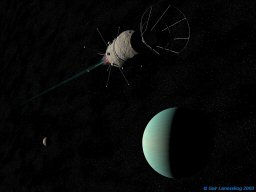 In
2160AD, the Battlestar began magnetic deceleration into the Tau Ceti system. The
colonists of Libertas, having settled the world in a faster ramscoop ship in 2135AD, took note of the
arrival and scrambled their small self-defense fleet of converted exploration
scouts and landing shuttles. Three outer system skirmishes forced Admiral
Narita to admit that attempts to seize control of the world, now home to over 16,000
colonists, or to peacefully settle on elsewhere on Libertas would be unsuccessful.
After negotiating a cease-fire via radio, the Battlestar resumed
acceleration, swinging through the outer system and heading toward nearby Epsilon Eridani, a forty-five year voyage. One hundred and three Easterners,
mostly soldiers, and three gunships were lost in the Libertas War.
In
2160AD, the Battlestar began magnetic deceleration into the Tau Ceti system. The
colonists of Libertas, having settled the world in a faster ramscoop ship in 2135AD, took note of the
arrival and scrambled their small self-defense fleet of converted exploration
scouts and landing shuttles. Three outer system skirmishes forced Admiral
Narita to admit that attempts to seize control of the world, now home to over 16,000
colonists, or to peacefully settle on elsewhere on Libertas would be unsuccessful.
After negotiating a cease-fire via radio, the Battlestar resumed
acceleration, swinging through the outer system and heading toward nearby Epsilon Eridani, a forty-five year voyage. One hundred and three Easterners,
mostly soldiers, and three gunships were lost in the Libertas War.
The Battlestar decelerated into the Epsilon Eridani system in 2205AD
and entered orbit around the most promising world, later dubbed Vulcan. This
planet was a warm proto-Martian world (Class W), with a moderately thick carbon
dioxide-nitrogen atmosphere and two small oceans.
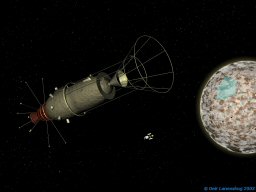 Entering orbit, an
Easterner gunship captured the automated orbital recon satellite placed there by the
Columbus in 2200AD. Drawing the conclusion that at least the
Atlantis colony on Alpha Centauri had developed faster than light
transportation, Admiral Narita ordered two hundred Easterners, three quarters of
them soldiers, to colonize and begin terraforming Vulcan. Leaving them a
gunship, a transport and a shuttle, five improved fabricators and a large number
of rapid cloning tanks and robotic units, the Battlestar stayed in orbit
just long enough to upgrade the ramscoop engine system and then headed for the 82
Eridani system, known from remote surveys to have two nitrogen-oxygen worlds. The vastly
improved drive systems allowed the Battlestar to accelerate to over one
third light speed. Depleted by continuing attrition from hibernation mishaps
and other accidents, five hundred seventy-six Easterners remained on the Battlestar as it headed
back into interstellar space.
Entering orbit, an
Easterner gunship captured the automated orbital recon satellite placed there by the
Columbus in 2200AD. Drawing the conclusion that at least the
Atlantis colony on Alpha Centauri had developed faster than light
transportation, Admiral Narita ordered two hundred Easterners, three quarters of
them soldiers, to colonize and begin terraforming Vulcan. Leaving them a
gunship, a transport and a shuttle, five improved fabricators and a large number
of rapid cloning tanks and robotic units, the Battlestar stayed in orbit
just long enough to upgrade the ramscoop engine system and then headed for the 82
Eridani system, known from remote surveys to have two nitrogen-oxygen worlds. The vastly
improved drive systems allowed the Battlestar to accelerate to over one
third light speed. Depleted by continuing attrition from hibernation mishaps
and other accidents, five hundred seventy-six Easterners remained on the Battlestar as it headed
back into interstellar space.
In 2216AD the Atlantian survey vessel Newton entered the Epsilon Eridani system and noted the existence of the Easterner colony, departing without detection. Despite Confederation indifference, Atlantian and Libertine military officials eventually began to consider independent action against the colony, though the high cost of interstellar transport stymied planning efforts. Over the next decade and a half, the Vulcan colony continued to expand rapidly, with the heavily clone-supplemented population reaching 35,000 by 2230AD and atmospheric oxygen beginning to reach noticeable levels from the terraformation effort.
In 2231AD after years of debate and planning, a joint task force of eight Atlantian starships and six Libertine gunboats invaded Epsilon Eridani, destroying the Vulcan space defenses, and bombarding the major settlement. A second wave of attacks landed three battalions of marines on the planet, starting a three-month campaign to pacify the world. The following year, the Atlantian and Libertine governments declared Vulcan open for colonization and maintained marital law, eventually designating all clones as Artificial Status beings, but granting Resident status to the surviving fifty-two Easterner colonists and their thirty-five fully natural descendents. Under questioning, the survivors eventually acknowledged that the Battlestar was en route to 82 Eridani, but left interrogators with the impression that the vessel could not exceed a quarter of light speed, implying an arrival sometime in 2251AD.
The Battlestar actually entered the 82 Eridani system in late 2239AD. While still decelerating towards the outer habitable world, dubbed Amaterasu by the Easterner crew, the Battlestar encountered and captured the CES Boone exploratory vessel and imprisoned its crew of forty. Determining the status of Vulcan and the state of Confederation military forces and intelligence, Admiral Narita ordered the settlement and fortification of Amaterasu, beginning immediate clone production to supplement troop strength. Top scientists began frantic work to duplicate Confederation technology, including macrojump, anti-matter distillation, molecular armor and hyper-string pseudo-gravity (HSPG) thruster technology. In 2240AD, the Easterners captured the CES Livingstone as it was retracing the path of the missing Boone. But despite the probable loss of two ships in the same system, Confederation investigators blamed the disappearances on potentially catastrophic flaws in the Shackelton Class vessels' jump engines and fail to follow up with a thorough search. After repeated interrogations, the Easterners interned the surviving crews of the Boone and Livingstone on Dante, the hot, dry, marginally habitable second planet of the 82 Eridani system. By late 2241AD Easterner scientists and engineers had begun production of Samurai Class HSPG thruster gunboats and the first experimental macrojump vessels.
In the following year, the first Libertine macrojump starship, Freedom, entered the 82 Eridani system only to be destroyed by the first operational Samurai gunboats. After several months, the CES, now suspicious of the 82 Eridani system rather than a technological flaw, dispatched the scout vessels Hillary and Scott to search for the overdue Freedom. But having determined the typical entry point for macrojump vessels, the Easterners ambushed the still unprepared Hillary and Scott immediately on entry. Though heavily damaged, the Scott managed escape the attack and jumped back to Epsilon Eridani to report the incident. Admiral Narita, now fearing imminent invasion, ordered a vigorous defense of Amaterasu, but begins preparations for evacuation if necessary.
In 2242AD, the Terran Confederation had yet to form unified Naval command, so political deliberations over a course of action and logistical coordination for a joint task force to attack 82 Eridani took over seven months to complete. In April 2243AD the Confederation Joint Expeditionary Force of twelve starships and ten gunboats finally jumped to a new emergence point in the outer 82 Eridani system. Admiral Narita directed harassment attacks against the inbound Confederation fleet and ambushed it in the Battle of Tartarus, during refueling operations at the inner gas giant. Easterner gunships crippled and captured the Terran flagship cruiser Invincible at Tartarus, killing Admiral Aaron Timmins, and destroyed the four other starships in the battle. Bereft of their commander and nearly half their fleet, the battered Expeditionary force retreated and jumped back to Libertas to regroup.
 In the intervening months, Narita ordered the Battlestar to
depart under
the command of Captain Shinzo Hiroshi with over three hundred sixty Easterners aboard. Scheduling ten-year work shifts of twelve
conscious crew members, the crew settled down for an over two hundred year journey toward the
galactic core at one-third light speed, eventually arriving at the by then long settled
colony world of Victoria in 2478AD. Additionally, Narita ordered his six
jury-rigged starships. with crews of twenty-four each, to set out coreward
to establish small enclaves.
The remaining Easterner forces deployed their gunships to defend their system
from an expected second Confederation attack.
In the intervening months, Narita ordered the Battlestar to
depart under
the command of Captain Shinzo Hiroshi with over three hundred sixty Easterners aboard. Scheduling ten-year work shifts of twelve
conscious crew members, the crew settled down for an over two hundred year journey toward the
galactic core at one-third light speed, eventually arriving at the by then long settled
colony world of Victoria in 2478AD. Additionally, Narita ordered his six
jury-rigged starships. with crews of twenty-four each, to set out coreward
to establish small enclaves.
The remaining Easterner forces deployed their gunships to defend their system
from an expected second Confederation attack.
After four months of refitting, bickering and a change of leadership, the Confederation Joint Expeditionary Force returned under the joint command of Terran Admiral Minghui Zhang aboard the Intrepid and Atlantian Admiral Tomas Johannessen aboard the North America. Bypassing outer defenses by jumping high off the orbital plane, the CJEF achieved orbital supremacy at the Battle of Amaterasu, a pitched struggle in which Admiral Narita perished in a successful suicide ramming attack on the Europa. With the Easterner fleet destroyed, subsequent bombardment prepared the way for the landing of a marine expeditionary force on the planet in early December 2243AD. Fighting between the occupation troops and Easterner defenders continued until the last mountain redoubts fell in May 2244AD.
Early in 2244AD, the Confederation raided the small base on Dante, destroying the garrison and rescuing the surviving CES crews from the Boone, Livingstone and Hillary. The final toll for the war, not including the three scout ships and the Freedom lost earlier, was seven Confederation starships and nine gunboats lost, with 3,083 soldiers killed and over two thousand injured. The Easterners lost all their remaining vessels but only four thousand people, mostly clones. Of the thirty-seven surviving Battlestar crew, the Confederation tried, convicted and executed twenty-five for war crimes; the remaining twelve, all scientists and engineers, suffered exiled to Dante.
The Confederation designated all surviving clones Artificial Status and opened Amaterasu for additional colonization in 2245AD. Interrogations and follow-up searches of coreward regions failed to find any hint of the six Easterner starships or trace of the Battlestar. Powered by the small anti-matter distiller from the Livingstone and some HSPG thrusters to supplement its ramscoop-fusion system, the Battlestar had accelerated out of the 82 Eridani system at .25 gravities, then coasted until distant enough to avoid detection of its ramscoop ignition.
The six Easterner macrojump ships made their way coreward. Their orders were to spread out and travel over one hundred light years toward the galactic core, then look for the first suitable planet to settle. Every vessel set out with a crew of two soldiers, two scientists and twenty clones - fully adult at the age of three force-grown years. In each ship’s hold were two fabricators, twenty rapid clone tanks and a dozen robotic assemblers. After seven to ten jumps, all six vessels found safe havens settling four worlds, Honshu, Shikoku, Manchukuo and Chosun in 2244AD and two, Formosa and Kyushu, in 2245AD.
Establishing a small settlement by essentially disassembling their starship and building a factory village to produce technological materials and new clone workers, the six colonies independently began what they thought would be a centuries-long effort to build a defensible interstellar society. Unfortunately, they picked the wrong direction to escape the Confederation's grasp, settling on the edge of M'kkiae space.
In late 2247AD, a M’kkiae patrol entered the Kyushu system and made contact with the nascent Easterner settlement there. Through a Khzraut translator, the M’kkiae learned the Easterner version of Human history. The M’kkiae absorbed the Kyushu colony as a subject world and conducted a perimeter sweep, discovering and occupying Chosun and Formosa in 2248AD. Based on Easterner information, the M’kkiae Council of Clans determined that Humanity constituted a threat to the M’kkiae Combine and began debate on the best method for neutralizing that danger. Additional M’kkiae sweeps in 2249AD discovered and occupied the three remain Easterner colonies and the first M’kkiae scout vessels soon reached Human space, scouting the 82 Eridani system.
The M’kkiae remained divided on whether to attack directly Sol, many realizing that their fleet strength has suffered from centuries of neglect. While the debate continued, the Combine began to arm the Easterner colonists, modifying the basic design of the Samurai gunships to provide better drives and sensors. By late 2250AD, the entire Easterner colony community could field seventy-one warriors, eleven soldiers originally from the Battlestar and sixty clones, enough to provide a command staff and five person crews for each of the ten initial modified Samurai gunships. Early in 2251AD, the M’kkiae Combine provided the Easterners with support from eight M'kkiae-crewed starships: five transports for the gunships, two cargo vessels to support forward bases, and a command ship to house the Easterner squadron command staff. Ironically, the pivotal M’kkiae War began with just sixty M'kkiae and four Khzraut translators supporting a total Easterner troop strength of seventy-one, though the six Easterner colony worlds quickly produced and trained more clone troopers.
In June 2251AD, a fleet of four Samurai gunships destroyed the Mulligan CES station, killing all thirty-six personnel on the orbital station and eight of fourteen at the surface station. The Easterners occupied the ground station temporarily, mined it, and then retreated before the next CES supply mission arrived. Later in the year, two Samurais destroyed the CES Nansen while it conducted a deep exploration mission on the coreward frontier.
 By the beginning of 2252AD, the Easterners fielded crews for twenty Samurai and
four Human operated jump-capable troop transports each carrying a clone company of
one hundred fifty troopers. They conduct raids against seven separate CES
installations to the coreward, north and south of Sol, including a raid that
destroyed the Ibn Buttuta and occupied the CES base at Delphi in the
Chara system. After two M’kkiae tenders supporting the Samurais were almost
discovered during the subsequent retreat from Delphi, the M’kkiae assisted in the production of six
Human-crewed tenders capable of supporting and transporting
four Samurai each. Late in the year, the Easterners established forward bases in the Arcturus and Fomalhaut systems
meant to support the second phase
of the attack on the Confederation: the capture of the colony worlds.
By the beginning of 2252AD, the Easterners fielded crews for twenty Samurai and
four Human operated jump-capable troop transports each carrying a clone company of
one hundred fifty troopers. They conduct raids against seven separate CES
installations to the coreward, north and south of Sol, including a raid that
destroyed the Ibn Buttuta and occupied the CES base at Delphi in the
Chara system. After two M’kkiae tenders supporting the Samurais were almost
discovered during the subsequent retreat from Delphi, the M’kkiae assisted in the production of six
Human-crewed tenders capable of supporting and transporting
four Samurai each. Late in the year, the Easterners established forward bases in the Arcturus and Fomalhaut systems
meant to support the second phase
of the attack on the Confederation: the capture of the colony worlds.
Early in 2253AD the Easterners launched an invasion of the 61 Virginis system with the goal of capturing the colony on Kalmar. The Atlantian First Fleet met the challenge, destroying five of the twelve attacking gunboats and two of the troop ships. The remainder of the Easterner attack fleet retreated to Arcturus to regroup. Later in the year the Arcturus Fleet launched another raid on Delphi, crippling the CES Armstrong and destroying its escort, the frigate ANS Powell. The second Easterner fleet, based on Fomalhaut V, began launching commerce raids against transports in the 82 Eridani, Epsilon Eridani and Tau Ceti systems. Other than firing a few missiles aimed at Libertine settlements, the Fomalhaut Fleet made no attempt to attack colony worlds directly.
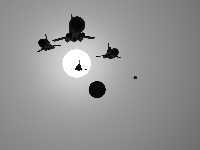 Back on
M’kkiae, the Council of Clans finally ended their Great Debate, reaching a
consensus that the Easterners were too few in number to complete Phase II on
their own. Also, M’kkiae spy expeditions found no evidence of purported
internal support for the Easterners on the colony worlds or in the Solar system.
As a result, the Council initiated a massive shipbuilding campaign to prepare the
Combine for full-scale warfare against Humanity, using the Easterners only as
intermediaries and shock troops. The M’kkiae battle plan called for nearly three
years of action to complete Phase II; at the end of this period, their fleet
strength was projected to be enough to subdue the Solar system and enslave
Humanity.
Back on
M’kkiae, the Council of Clans finally ended their Great Debate, reaching a
consensus that the Easterners were too few in number to complete Phase II on
their own. Also, M’kkiae spy expeditions found no evidence of purported
internal support for the Easterners on the colony worlds or in the Solar system.
As a result, the Council initiated a massive shipbuilding campaign to prepare the
Combine for full-scale warfare against Humanity, using the Easterners only as
intermediaries and shock troops. The M’kkiae battle plan called for nearly three
years of action to complete Phase II; at the end of this period, their fleet
strength was projected to be enough to subdue the Solar system and enslave
Humanity.
In early 2254AD, the initial M’kkiae attack fleet, supported by Easterner auxiliaries and scouts, mustered at Fomalhaut and jumped to the 82 Eridani system, beginning the first combined campaign of the war. The remaining eight years of warfare is a history of M'kkiae-Confederation conflict, to which the Easterner influence became secondary and this story is best told in another article.
The future of the Easterner exodus lay once again with the crew of the Battlestar.
The Battlestar continued its long sub-light voyage toward the
colony world of Victoria even as the Confederation collapsed into chaos and
darkness after the Secession War. Of the three hundred sixty-eight Easterners that left Amaterasu,
three hundred nineteen Easterners remained alive when the
Battlestar decelerated into the Victoria system in early 2478AD after over
two centuries of travel. At
that time the
colony, settled by old British Nobility in 2313AD, had less than seven thousand
residents, mostly living on sprawling, crumbling overgrown estates, suffering from a
lack of labor after the robots began to fail. Victoria's basic
technological level had fallen to late 20th Century standards, but the world had no
working spacecraft or a functional satellite grid. Upon arrival, Captain
Hiroshi ordered his entire crew complement awakened and guided the Battlestar
into a synchronous orbit over an uninhabited region of the world.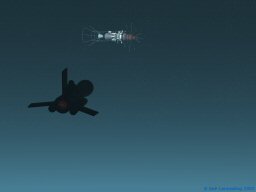
After a month of intelligence gathering, Hiroshi launched a full assault with all four Samurai gunships and deployed his two transports as troopships. The Victoria House of Peers surrendered after a single week of conflict and the technologically superior and battle-hardened Easterner soldiers put down the few resistors within a month. Triumphantly landing in the ruined capitol courtyard, Hiroshi renamed the world Hachiman and began rapidly cloning an Easterner population base.
After discovering the current collapsed condition of Human space and slowly realizing the amount of time necessary to produce a viable spacefaring society, Captain Hiroshi sketched out a two hundred year development plan to produce an industrialized interstellar society. To preserve his cadre, Hiroshi continued the practice of hibernation shifts, with ten leaders chosen to govern for twenty ten-year periods starting in 2480AD; Hiroshi ordered his own revival set for 2680AD.
The original Victoria colonists died out within the first few decades of Easterner rule, succumbing to the hardships of forced labor. After an initial surge created over two hundred thousand clones, the Easterner population continued to increase rapidly but steadily, with additional clones supplementing the high natural increase of the first wave of clone laborers. Under the guidance of the Battlestar leadership, Hachiman became a functional hierarchical society, slowly spreading out over the habitable portions of the planet in a civilization that was sequentially agricultural, industrial and finally technologically-based. By 2580AD, the population was over twelve million, and native industry had reach early 21st Century information era levels. By 2680AD, the population topped one hundred million and industry had reached mid 22nd Century late fusion era levels. When Hiroshi awakened in 2680AD, he ordered the full Battlestar compliment revived and began planning for an interstellar civilization.
It took an additional forty years to achieve Hiroshi’s goal. The prototype macrojump vessel, the Yamamoto, made its first flight in 2721AD. Equipped with vacuum distillation generators and HSPG drives, it demonstrated that Hachiman civilization was ready for expansion. Hiroshi, now suffering from advanced cancer, ordered the construction of a battle fleet, complete with large troop ships, tenders, and wings of the proven Samurai gunships. At the dawn of its Imperial Era, the Hachiman population was over two hundred million and its technology had reached nearly mid 23rd Century levels. As Hiroshi lay on his deathbed, he named Hideki Tanaka as his successor. At Hiroshi's death in 2722AD, two hundred and five Battlestar veterans still remained alive.
Tanaka named himself Fleet Admiral of the Hachiman Navy and in late 2723AD the Hachiman First Fleet entered the Heaven system, ordering the planet to surrender. After the Presidium refused to comply, the First Fleet opened fire, raining nuclear missiles on major military and population centers, killing over two million people before Hachiman marines descended to occupy the planet and seize control of the populace.
The following year, a Kalmar Pact trading expedition first entered the Hachiman system. After a tense standoff, the Pact vessel returned to Kalmar with a Hachiman ambassador. Admiral Tanaka declared a military exclusion zone around Heaven, forbidding Pact contact with occupied world.
In 2727AD the Pact and Hachiman formally exchange embassies and informally agree on spheres of influence. In the same year, Hachiman task forces re-contacted the old Easterner colonies, fairly peacefully absorbing the surviving colonies on Honshu, Manchukuo and Formosa and staking claim to the other three worlds, establishing small colonies on those deserted worlds before the end of the decade.
Growing bolder, Tanaka personally commanded the First Fleet in an attack on Han in 2730AD, conquering the major settlements and beginning a decades-long struggle to fully subdue the Southern Islands of that world. Two years later, the Hachiman Second Fleet overran the primitive world of Gothia, and two years after that, the Second Fleet occupied the low population world of Ch’in. Late in 2734AD, secure in his capital, Admiral Tanaka declared himself Emperor Hideki of the growing Hachiman Empire. After some hesitation, the Kalmar Pact recognized the Empire in return for assurances of an end to further conquests, though the Pact quickly conceded to Hachiman settlement of the failed colony world of Catalonia in the following year.
The Hachiman Empire and the Kalmar Pact remained on fairly good terms until 2746AD, when Hachiman entered a “voluntary union” with Champa, a Pact world for over two hundred years. The Pact suspected that the Champan government agreed to the union only after bribery and threats, but Atlantis remained reluctant to challenge Hachiman over what appeared on the surface to be a voluntary decision. Relations remained rocky with most Pact members, but trade with Atlantis increased. By 2750AD, the Hachiman Empire encompassed thirteen worlds and over three hundred forty million people.
In 2769AD, Hachiman took advantage of the split between Atlantis and the weakening Kalmar Pact to subdue and occupy Teutonia with little more than ineffectual Pact denunciations. Later, the Hachiman Empire joined with Atlantis and Libertas in the TriWorld Alliance against the Kalmar Pact and helped instigate the Pact War in 2784AD by occupying the Pact facility on Asgard and conquering uncontacted Bolivar. During the next few years of fighting, Hachiman forces attacked Deseret, using nuclear and biological weapons to attempt to conquer the world and also occupied Heimdall and several Pact outposts. After defeat at the hands of Terran Imperial forces at the Battle of Kalmar in 2787AD, Emperor Hideki agreed to a cease-fire and evacuated all his war gains save for Asgard and Bolivar. By 2789AD, all of recontacted Human space, except the seventeen systems of the Hachiman Empire, joined the Empire of Humanity.
Relations between the Empire of Humanity and the Hachiman Empire were never good. King John of Libertas, who had expediently allied with Hachiman against the Pact, quickly returned to his anti-Easterner rhetoric and contributed to the break in diplomatic relations between the two Empires in 2798AD. The Hachiman Empire continued a careful expansion into uncontacted space and established a forward military base in the Vega System, but it was alleged support for piracy, long a Libertine, not Hachiman, policy, that was the immediate precipitant for the outbreak of the Hachiman War in 2801AD.
The numerically superior forces of the Empire of Humanity quickly attacked and defeated the Hachiman Navy at outlying worlds and installations, including Vega, and handily defeated the Hachiman counterattack on Prometheus. In the next year of warfare, Emperor Rogar adopted an "island hoping" campaign reminiscent of the Second World War Pacific Campaigns to isolate Hachiman garrisons and tighten the noose on the world itself. The discovery of a pirate base on Diakoku confirmed claims of Hachiman support for piracy and encouraged a "final solution" to the Hachiman problem.
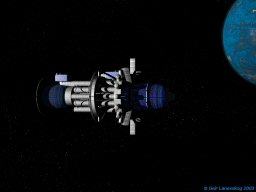 Fearing imminent invasion, Emperor Hideki
ordered his son, Crown Prince Hirohito, to take one thousand skilled loyalists
and their families and travel far to coreward aboard the renovated macrojump-equipped Battlestar, the
largest such vessel ever created. Departing in July 2803AD, they vanished
from history.
Fearing imminent invasion, Emperor Hideki
ordered his son, Crown Prince Hirohito, to take one thousand skilled loyalists
and their families and travel far to coreward aboard the renovated macrojump-equipped Battlestar, the
largest such vessel ever created. Departing in July 2803AD, they vanished
from history.
The Apollyon and Beelzebub Hellking battle groups arrived in the Hachiman system in August 2803AD and bombarded the surface with disintegrators and multi-gigaton antimater bombs for six hours, rendering large portions of the surface uninhabitable and killing over one hundred million people before Hideki and the Hachiman fleet finally surrendered. Within a year, the Empire of Humanity had seized the remnants of the Hachiman Empire. A military tribunal tried and executed Emperor Hideki and fourteen senior officers after trials for their crimes against Humanity, resulting from the occupation of Heaven, Ch'in and Han, and for their support of piracy.
After the war, the world of Hachiman endured a fifty year period of marital law. In 2854AD the world, renamed Nova by a reformed populace, finally became a full and free member of the Empire of Humanity. Over the ensuing centuries, the people of Nova worked to distance themselves from their Easterner heritage, eventually overcoming class divisions between Naturals and clone descendants, and the Easterner legacy faded from Imperial consciousness.
Despite a prolonged search of hundred of coreward systems, the naval and scout ships of Empire of Humanity were unable to locate the trail of the Battlestar's final exodus. In the fifth millennium, an exhaustive historical study of Grand Federation records conducted by IAK researchers indicated a single contact between the Battlestar and Kith'turi traders in Sector 366 sometime in late 3805AD and Kraz records hinted at a sighting in Sector 757 in the following year. The Battlestar probably headed Spinward and South from that last sighting, arriving somewhere close to Sector +14,+02,-05 by the end of the decade.
After fourteen hundred years of absence, the Easterners reentered history in 4209AD when a Dragon scouting expedition encountered a Human colony while exploring beyond the Dragon spinward frontier. The Dragons, fearing a secret Human encirclement, used this encounter as the pretext for the Dragon War of 4210-4216AD. Even after the end of that war, the Dragons refused to allow contact or to provide any information about the distant Human state, which became known popularly as the Cygnian Realm, and all contact expeditions by the Empire of Humanity or private parties met with failure, though the Second Cygnus Expedition's last drone message confirmed the supposition that the Cygnians were Easterner descendants.
Jon Gades, whose second Incarnation presumably disappeared near Cyngian space in the 41st Century, set out on a Merchant Guild-sponsored contact attempt in the 58th Century during his fifth Incarnation, but that expedition also failed to return.
Knowledge of the current status of the Cygnian Realm remains scant. Most Dragon accounts indicate that the Realm is a microjump-capable united Human state, perhaps encompassing two to three thousand systems, including the area around Deneb. The Dragons indicate that the Realm did suffer the disruptions of the Mech Plague, but that it retained a united interstellar culture throughout the Chaotic Era. Current culture, language and disposition are purely speculative, though relations with the Dragon States appear uniformly hostile.
Based on an approximately 600m by 300m planetoid body, the Battlestar was the first Human interstellar craft. The vehicle, originally dubbed the X-400 by JAXA, was a prototype ramscoop explorer. The initial vehicle measured 838 meters long from its forward to rear magnetic extenders and massed over twenty million tons, mostly from the remaining honeycombed planetoid structure. Prewar plans called for an initial five-year Oort Cloud expedition departing in 2054AD and a possible expedition to Alpha Centauri departing in the early 2060s and arriving some fifty years later. While the ramscoop and magnetic inducers were ready for testing by 2052AD, the interior systems were far from complete when Admiral Narita seized DSRS 4 near the end of the Last World War. The Admiral wisely included the best technical minds at the research station in the crew of the Battlestar when he ordered its departure for Tau Ceti, and their work continued throughout the long shifts as the vessel cruised interstellar space. At each stop, Tau Ceti, Epsilon Eridani, 82 Eridani and finally Victoria/Hachiman, the Battlestar underwent major renovations to incorporate modern systems. With every improvement less of the original asteroid mass remained, until, at its final departure from Hachiman in 2803AD, the entire original asteroid was gone. The final vehicle measured just under 600m long and massed nearly twelve million tons.
The above table illustrates the Battlestar exterior configuration and sub-surface detail for each incarnation of the vehicle except for the 2803AD variation. The 2803AD, presumably final, incarnation of the Battlestar was a unique vehicle, incorporating twin macrojump generators, each generating an unprecedented 300m field. Twin field control remains an extremely delicate and computationally difficult challenge, and few production macrojump vehicles have ever utilized this technique. Plague-induced engineering restrictions, to say nothing of cost, have limited the size of macrojump field to less than 100m in the current era, making duplication of the final Battlestar design impossible.
All pages and images ©1999 - 2005
by Geir Lanesskog, All Right Reserved
Usage Policy
![]()